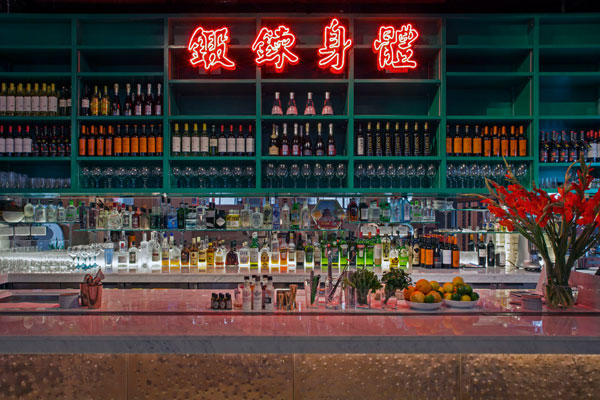Ping Pong is generating new levels of urban-chic in one of the oldest districts on Hong Kong Island, writes Martine Beale.

May 15th, 2014
Ping Pong sits at number 129 on the lower west side of Second Street in Sai Ying Pun. Like most of its surroundings, it is undergoing a face-lift and the street has become a ribbon decorated with damp low-rises, ‘for rent’ signs, half built shapes swathed in bamboo and netting, and new shiny pencil towers jostling for attention.
Blink as you walk by and you might miss this new Spanish themed Gintonería – and that would be a pity, because it’s spacious, inviting, and quite possibly one of the coolest bars to open west of Central.
Entry to the place is made through a rather nondescript red door at street level and a steep staircase that leads down into an extraordinary and generous space that imbues an airy and intimate neighbourhood vibe.
Part of its lofty impression can be attributed to its heritage as a ping pong hall gifted with a magnificent 5-metre ceiling, which is a common, and highly attractive construct within the formative spaces being snapped up for redevelopment.
The retention of original elements – the railings, vintage windows, and walls – carry history in a fresh, simplistic industrial cocoon weighted by preservation and modernity to favourable balance.
The transformation from run-down shell to hipster hotspot was presided over by designer Hugh Zimmern, the expert hands behind several large hospitality projects that include Gaia, Classified and Isobar.
“We retained as much as possible because we wanted something local in flavour rather than something that looked like it had been plonked there by a spaceship,” says the designer.
Ping Pong’s wide, open interior is peppered with groups of stylish wooden tables and chairs that invite gatherings and conversation. Comfy lounge chairs upholstered in black and white juxtapose grey concrete columns that rise up from the floor to meet a ceiling fitted with converted theatre and television lights from the 50s and 60s. The floor is sprinkled with rugs that lend a cosy feel underfoot.
In keeping with the neighbourhood vibe, aged concrete walls are adorned with art created mostly by local artists. These comprise an original by the King of Kowloon, a window piece by Nadim Abbas, and photographs by Caroline Chu.
A huge bar with an equally large neon sign that says “Train Your Body” in Chinese dominates one wall. This is where the forty or so gins from around the world and the dozen from niche Spanish distilleries are paired with an array of garnishes and different tonics.
“I love gin and tonic and the serious way that the Spanish drink it,” declares Zimmern. “They have taken a drink associated with aging colonials festering in seaside boarding houses and turned it into something hip and happening.” Which, in a way, is what he’s done with Ping Pong.
When the opportunity of the space arose, Zimmern formed the theme and the team. Design was handled by Faux Ltd., where Zimmern is a partner and director, with Lilian Tang Design handling graphics and Pacific Lighting and Light Directions overseeing lighting.
The project took just nine months and since opening has been met with success. The impeccable styling and unique character of Ping Pong is refreshing, and a welcome respite from the rapid gentrification occurring in the district.
A searchable and comprehensive guide for specifying leading products and their suppliers
Keep up to date with the latest and greatest from our industry BFF's!

Suitable for applications ranging from schools and retail outlets to computer rooms and X-ray suites, Palettone comes in two varieties and a choice of more than fifty colours.

Sub-Zero and Wolf’s prestigious Kitchen Design Contest (KDC) has celebrated the very best in kitchen innovation and aesthetics for three decades now. Recognising premier kitchen design professionals from around the globe, the KDC facilitates innovation, style and functionality that pushes boundaries.

Create a configuration to suit your needs with this curved collection.

Marylou Cafaro’s first trendjournal sparked a powerful, decades-long movement in joinery designs and finishes which eventually saw Australian design develop its independence and characteristic style. Now, polytec offers all-new insights into the future of Australian design.
Zenith Interiors celebrated the opening of their Auckland and Wellington showrooms at the end of July. The theme was Top Hats and Tiaras – which guests interpreted in many fun and different ways! Cocktails and Candy Lane Dancers kept the crowd entertained well into the night.
Michael Leung started HK Honey in 2009 after relocating to Hong Kong from London, building a creative career centred on urban beekeeping. Ben McCarthy has this story.
The internet never sleeps! Here's the stuff you might have missed

Found within the verdant landscape of Jubilee Hills, Hyderabad, Sona Reddy’s design for this authentic Andhra restaurant adeptly fuses textural rhythms with traditional materials.

An entry by MuseLAB, in The Retail Space in the 2024 INDE.Awards, takes shoppers to another planet where diamonds and great interior design make a lasting impression.